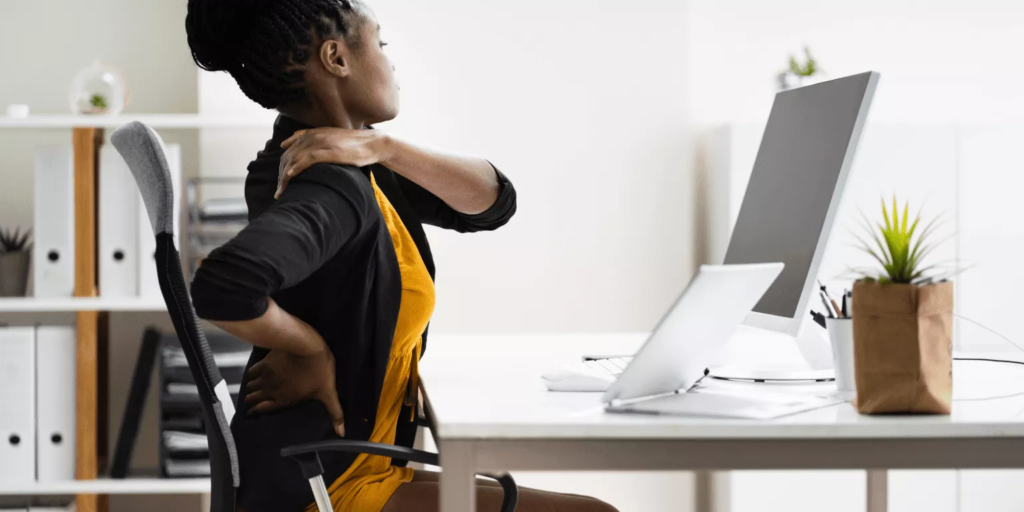Text neck syndrome is a real thing and it’s on the rise particularly amongst students. In this article I describe the symptoms and share top tips for students.
I can’t believe I used to wake up early, leave my house and squash myself onto a packed train to go and sit in front of a computer.
It’s 23/3/20 and lockdown restrictions have been announced, we’re told that studying is to be undertaken remotely from home. Utter panic. No one is clear how we’re going to attend classes from home. Some have no laptops or internet, the switch is sudden, it all seems impossible. You see we had relied on the physical library for so long. There was a lot to learn in a rather short time. And on top of that, there was a deadly pandemic raging throughout the world. Notwithstanding, within a couple of weeks many were familiar with Zoom and Microsoft Teams.
Fast forward to today and many of us are perhaps reaping the benefits of remote learning. For example saving money on commuting, the flexibility of attending multiple classes and meetings, all in the comfort of my couch, I could go on… With the many benefits to come with it, life has somewhat been simplified. However, a new trend has emerged alongside remote working, known as ‘Text Neck’.
What is Text Neck syndrome?
This term is used to describe neck pain and damage from looking up and down at the computer. This could be using mobile phones or tablets for prolonged periods of time with little movement. This causes the neck and shoulder pain and damage to the spine, some refer to it as the ‘Tech neck’. Although initially commonly associated with texting, today it’s related to many activities especially remote learning.
Here’s the thing, education has changed forever whereby now most teaching is undertaken remotely and on digital platforms (Hybrid model). Many believe the Hybrid model of education as the best way forward with many benefits of which I have tasted. For example attending classes regardless of location (imagine how much an international students could save on visa fees and accommodation). However, the more popular remote working is becoming the more popular ‘Tech Neck’ is becoming from spending prolonged times at the work desk in front of a screen sitting in a bad posture and in the break, we switch to the phones on twitter, Instagram, or funny videos on TikTok.
Signs of text neck syndrome:
Headaches, stiffness of shoulders, postural change, pain in the neck, back, hands, arms, shoulders, wrists, fingers, elbows, tingling or numbness in the upper extremities, soreness in the neck. Although most people are at risk due to being digitally prone, students are most the affected and it has affected our mental wellbeing.
How is remote learning impacting the students’ mental wellbeing?
Remote learning fosters feelings of isolation, disconnect and loneliness which may cause stress. Boundaries often become blurred especially when students don’t know when to switch off to do other things, some feel guilt that because they’ve been home, they haven’t done enough, so they keep going. This gradually affects their motivation and productivity leading to burnout. With online classes and keeping up with social media, we spend prolonged periods in front of a screen. That’s why use of mobile phones has increased during the pandemic. This has left some students addicted to their smart phones and several studies have indicated that social media may lead to low self-esteem issues, anti-social behaviors, and unhealthy snacking amongst many others. To those who are good with boundaries once they switch off, they have a nap and then this may end up disrupting their sleep routine which then impacts on mood.
Prevention:
Maintaining good posture is one of best ways to avoid ‘Tech Neck;’ by sitting with the body aligned perfectly maintaining the spine’s natural curvature. Picture yourself with your head being pulled upwards towards the ceiling by a string attached to the top of it. I have stopped slouching and instead I sit squarely to my screen minimizing looking down for prolonged periods time. Additionally, I try holding my phone at eye level as much as possible and I ensure I have frequent breaks in between, if seated, I get up and walk every 20-30 minutes.
Final thoughts:
However difficult things seem, remember there is support available. Most universities have wellbeing departments with wellbeing advisers who are experienced in supporting students. Students Unions may also help with basic life advice and Signposting to University facilities. Student minds offers support or speak to your GP. There is also self-support with leaflets available to download at https://web.ntw.nhs.uk/selfhelp/
Try to be patient with yourself, remember people don’t care about you as much you care about you, it’s not your job to fix what they won’t, and lastly your worth is not based on what you do or achieve.

